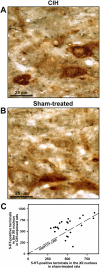Chronic intermittent hypoxia alters density of aminergic terminals and receptors in the hypoglossal motor nucleus
- PMID: 20622040
- PMCID: PMC3001268
- DOI: 10.1164/rccm.200912-1884OC
Chronic intermittent hypoxia alters density of aminergic terminals and receptors in the hypoglossal motor nucleus
Abstract
Rationale: Patients with obstructive sleep apnea (OSA) adapt to the anatomical vulnerability of their upper airway by generating increased activity in upper airway-dilating muscles during wakefulness. Norepinephrine (NE) and serotonin (5-HT) mediate, through α₁-adrenergic and 5-HT₂A receptors, a wake-related excitatory drive to upper airway motoneurons. In patients with OSA, this drive is necessary to maintain their upper airway open. We tested whether chronic intermittent hypoxia (CIH), a major pathogenic factor of OSA, affects aminergic innervation of XII motoneurons that innervate tongue-protruding muscles in a manner that could alter their airway-dilatory action.
Objectives: To determine the impact of CIH on neurochemical markers of NE and 5-HT innervation of the XII nucleus.
Methods: NE and 5-HT terminal varicosities and α₁-adrenergic and 5-HT₂A receptors were immunohistochemically visualized and quantified in the XII nucleus in adult rats exposed to CIH or room air exchanges for 10 h/d for 34 to 40 days.
Measurements and main results: CIH-exposed rats had approximately 40% higher density of NE terminals and approximately 20% higher density of 5-HT terminals in the ventromedial quadrant of the XII nucleus, the region that controls tongue protruder muscles, than sham-treated rats. XII motoneurons expressing α₁-adrenoceptors were also approximately 10% more numerous in CIH rats, whereas 5-HT₂A receptor density tended to be lower in CIH rats.
Conclusions: CIH-elicited increase of NE and 5-HT terminal density and increased expression of α₁-adrenoceptors in the XII nucleus may lead to augmentation of endogenous aminergic excitatory drives to XII motoneurons, thereby contributing to the increased upper airway motor tone in patients with OSA.
Figures






Similar articles
-
Effect of chronic intermittent hypoxia on noradrenergic activation of hypoglossal motoneurons.J Appl Physiol (1985). 2012 Jan;112(2):305-12. doi: 10.1152/japplphysiol.00697.2011. Epub 2011 Oct 20. J Appl Physiol (1985). 2012. PMID: 22016369 Free PMC article.
-
Circadian dependence of receptors that mediate wake-related excitatory drive to hypoglossal motoneurons.Respir Physiol Neurobiol. 2013 Sep 15;188(3):301-7. doi: 10.1016/j.resp.2013.04.024. Epub 2013 May 9. Respir Physiol Neurobiol. 2013. PMID: 23665050 Free PMC article.
-
Transient upregulation of TASK-1 expression in the hypoglossal nucleus during chronic intermittent hypoxia is reduced by serotonin 2A receptor antagonist.J Cell Physiol. 2019 Aug;234(10):17886-17895. doi: 10.1002/jcp.28419. Epub 2019 Mar 12. J Cell Physiol. 2019. PMID: 30864194
-
Noradrenergic modulation of hypoglossal motoneuron excitability: developmental and putative state-dependent mechanisms.Arch Ital Biol. 2011 Dec 1;149(4):426-53. doi: 10.4449/aib.v149i4.1271. Arch Ital Biol. 2011. PMID: 22205594 Review.
-
Serotonin and NMDA receptors in respiratory long-term facilitation.Respir Physiol Neurobiol. 2008 Dec 10;164(1-2):233-41. doi: 10.1016/j.resp.2008.05.016. Respir Physiol Neurobiol. 2008. PMID: 18606575 Free PMC article. Review.
Cited by
-
Loss of motoneurons in the ventral compartment of the rat hypoglossal nucleus following early postnatal exposure to alcohol.J Chem Neuroanat. 2013 Sep;52:87-94. doi: 10.1016/j.jchemneu.2013.07.003. Epub 2013 Aug 8. J Chem Neuroanat. 2013. PMID: 23932955 Free PMC article.
-
Sleep-wake control of the upper airway by noradrenergic neurons, with and without intermittent hypoxia.Prog Brain Res. 2014;209:255-74. doi: 10.1016/B978-0-444-63274-6.00013-8. Prog Brain Res. 2014. PMID: 24746052 Free PMC article.
-
Central and peripheral factors contributing to obstructive sleep apneas.Respir Physiol Neurobiol. 2013 Nov 1;189(2):344-53. doi: 10.1016/j.resp.2013.06.004. Epub 2013 Jun 11. Respir Physiol Neurobiol. 2013. PMID: 23770311 Free PMC article. Review.
-
Brown Adipose Tissue Activation Is Involved in Atherosclerosis of ApoE-/- Mice Induced by Chronic Intermittent Hypoxia.Front Cardiovasc Med. 2021 Oct 26;8:751519. doi: 10.3389/fcvm.2021.751519. eCollection 2021. Front Cardiovasc Med. 2021. PMID: 34765657 Free PMC article.
-
Daily acute intermittent hypoxia enhances serotonergic innervation of hypoglossal motor nuclei in rats with and without cervical spinal injury.Exp Neurol. 2022 Jan;347:113903. doi: 10.1016/j.expneurol.2021.113903. Epub 2021 Oct 24. Exp Neurol. 2022. PMID: 34699788 Free PMC article.
References
-
- Remmers JE, DeGroot WJ, Sauerland EK, Anch AM. Pathogenesis of upper airway occlusion during sleep. J Appl Physiol 1978;44:931–938. - PubMed
-
- White DP. The pathogenesis of obstructive sleep apnea: advances in the past 100 years. Am J Respir Cell Mol Biol 2006;34:1–6. - PubMed
-
- Suratt PM, McTier RF, Wilhoit SC. Upper airway muscle activation is augmented in patients with obstructive sleep apnea compared with that in normal subjects. Am Rev Respir Dis 1988;137:889–894. - PubMed
-
- Hendricks JC, Petrof BJ, Panckeri K, Pack AI. Upper airway dilating muscle hyperactivity during non-rapid eye movement sleep in English bulldogs. Am Rev Respir Dis 1993;148:185–194. - PubMed
Publication types
MeSH terms
Substances
Grants and funding
LinkOut - more resources
Full Text Sources
Molecular Biology Databases

